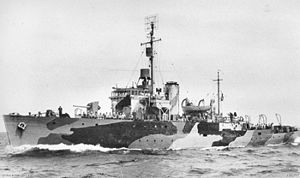HMAS Horsham

| |
| History | |
|---|---|
| Namesake | City of Horsham, Victoria |
| Builder | HMA Naval Dockyard |
| Laid down | 26 June 1941 |
| Launched | 16 May 1942 |
| Commissioned | 18 November 1942 |
| Decommissioned | 17 December 1945 |
| Fate | Sold for scrap in 1956 |
| General characteristics | |
| Class and type | Bathurst-class corvette |
| Displacement | 650 tons (standard), 1,025 tons (full war load) |
| Length | 186 ft (57 m) |
| Beam | 31 ft (9.4 m) |
| Draught | 8.5 ft (2.6 m) |
| Propulsion | triple expansion engine, 2 shafts, 2,000 horsepower |
| Speed | 15.5 knots (28.7 km/h; 17.8 mph) |
| Complement | 85 |
| Armament |
|
HMAS Horsham (J235/M235), named for the city of Horsham, Victoria, was one of 60 Bathurst-class corvettes constructed during World War II, and one of 36 initially manned and commissioned solely by the Royal Australian Navy (RAN).[1]
Design and construction
[edit]In 1938, the Australian Commonwealth Naval Board (ACNB) identified the need for a general purpose 'local defence vessel' capable of both anti-submarine and mine-warfare duties, while easy to construct and operate.[2][3] The vessel was initially envisaged as having a displacement of approximately 500 tons, a speed of at least 10 knots (19 km/h; 12 mph), and a range of 2,000 nautical miles (3,700 km; 2,300 mi)[4] The opportunity to build a prototype in the place of a cancelled Bar-class boom defence vessel saw the proposed design increased to a 680-ton vessel, with a 15.5 knots (28.7 km/h; 17.8 mph) top speed, and a range of 2,850 nautical miles (5,280 km; 3,280 mi), armed with a 4-inch gun, equipped with asdic, and able to fitted with either depth charges or minesweeping equipment depending on the planned operations: although closer in size to a sloop than a local defence vessel, the resulting increased capabilities were accepted due to advantages over British-designed mine warfare and anti-submarine vessels.[2][5] Construction of the prototype HMAS Kangaroo did not go ahead, but the plans were retained.[6] The need for locally built 'all-rounder' vessels at the start of World War II saw the "Australian Minesweepers" (designated as such to hide their anti-submarine capability, but popularly referred to as "corvettes") approved in September 1939, with 60 constructed during the course of the war: 36 (including Horsham) ordered by the RAN, 20 ordered by the British Admiralty but manned and commissioned as RAN vessels, and 4 for the Royal Indian Navy.[2][7][8][9][1]
Horsham was laid down by HMA Naval Dockyard at Melbourne, Victoria on 26 June 1941.[1] She was launched on 16 May 1942, and was commissioned into the RAN on 18 November 1942.
Operational history
[edit]Horsham entered active service in January 1943.[1] She was initially assigned to Fremantle as an anti-submarine patrol ship, where she remained until August 1944.[1] The corvette was then deployed to Darwin as a survey ship, and remained there until the end of World War II.[1] In September 1945, Horsham was present at the Japanese surrender of Timor.[1] She continued in the survey role until November 1945, when she returned to Fremantle.[1]
Decommissioning and fate
[edit]Horsham paid off into reserve in Fremantle on 17 December 1945.[1] She was sold for scrapping to the Hong Kong Delta Shipping Company on 8 August 1956.[1]
Citations
[edit]- ^ a b c d e f g h i j "HMAS Horsham (I)". HMA Ship Histories. Sea Power Centre - Royal Australian Navy. Retrieved 26 December 2008.
- ^ a b c Stevens, The Australian Corvettes, p. 1
- ^ Stevens, A Critical Vulnerability, p. 103
- ^ Stevens, A Critical Vulnerability, pp. 103–4
- ^ Stevens, A Critical Vulnerability, pp. 103–5
- ^ Stevens, A Critical Vulnerability, p. 104
- ^ Stevens, A Critical Vulnerability, pp. 105, 148
- ^ Donohue, From Empire Defence to the Long Haul, p. 29
- ^ Stevens et al., The Royal Australian Navy, p. 108
References
[edit]- Books
- Donohue, Hector (October 1996). From Empire Defence to the Long Haul: post-war defence policy and its impact on naval force structure planning 1945–1955. Papers in Australian Maritime Affairs. Vol. 1. Canberra: Sea Power Centre. ISBN 0-642-25907-0. ISSN 1327-5658. OCLC 36817771.
- Stevens, David (2005). A Critical Vulnerability: the impact of the submarine threat on Australia's maritime defense 1915–1954. Papers in Australian Maritime Affairs. Vol. 15. Canberra: Sea Power Centre Australia. ISBN 0-642-29625-1. ISSN 1327-5658. OCLC 62548623.
- Stevens, David; Sears, Jason; Goldrick, James; Cooper, Alastair; Jones, Peter; Spurling, Kathryn (2001). Stevens, David (ed.). The Royal Australian Navy. The Australian Centenary History of Defence (vol III). South Melbourne, VIC: Oxford University Press. ISBN 0-19-554116-2. OCLC 50418095.
- Journal and news articles
- Stevens, David (May 2010). "The Australian Corvettes" (PDF). Hindsight (Semaphore). 2010 (5). Sea Power Centre – Australia. Archived from the original (PDF) on 20 March 2011. Retrieved 13 August 2010.
